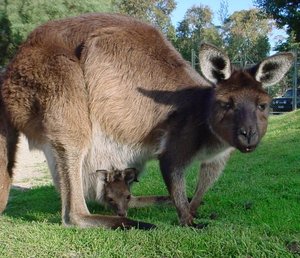Western Grey Kangaroo
|
|
| Western Grey Kangaroo | ||||||||||||||||
|---|---|---|---|---|---|---|---|---|---|---|---|---|---|---|---|---|
| Scientific classification | ||||||||||||||||
| ||||||||||||||||
| Binomial name | ||||||||||||||||
| Macropus fuliginosus |
The Western Grey Kangaroo (Macropus fuliginosis) is a large and very common macropod, found across almost the entire southern part of Australia, from just south of Shark Bay to coastal South Australia, western Victoria, and the entire Murray-Darling Basin in New South Wales and Queensland.
Long known to the Aboriginal people of Australia, for Europeans, the Western Grey was the centre of a great deal of sometimes comical taxonomic confusion for almost 200 years. It was first noted by European settlers when the great explorer Matthew Flinders landed on Kangaroo Island in 1802. Flinders shot several for food but assumed that they were Eastern Grey Kangaroos. In 1803 French explorers captured several Kangaroo Island Western Greys and shipped them home to Paris, where they lived in the zoological gardens for some years. Eventually, researchers at the Paris Museum of Natural History recognised that these animals were indeed different and formally described the species as Macropus fuliginosus in 1817. Unfortunately, for reasons that remain unclear, it was described as native to Tasmania!
There the matter rested for over 100 years, and it was not until 1917 that researchers realised that the "Forester Kangaroo" of Tasmania was in fact Macropus giganteus, the same Eastern Grey Kangaroo that was, and still is, widespread in the more fertile south-eastern part of the mainland. By 1971, it was understood that the Kangaroo Island species was the same as the kangaroos of southern Western Australia, and that this population exended through much of the eastern part of the continent s well. For a time, three subspecies were described, two on the mainland and one on Kangaroo Island. Finally, by the early 1990s, the current understanding energed.
There are two subspecies of the Western Grey: Macropus fuliginosus fuliginosus of Kangaroo Island, and Macropus fuliginosus melanops, which has a range of different forms that intergrade clinallly from west to east.
The Western Grey is not found in the tropical north or the fertile south-east of Australia, and the Eastern Grey does not extend beyond the NSW-South Australia border, but the two species are both common in the Murray-Darling Basin area. They never interbreed in the wild, although it has proved possible to produce hybrids between Eastern Grey females and Western Grey males in captivity.
The Western Grey Kangaroo is also referred to as a Stinker, Black-faced Kangaroo, Mallee Kangaroo or Sooty Kangaroo.

